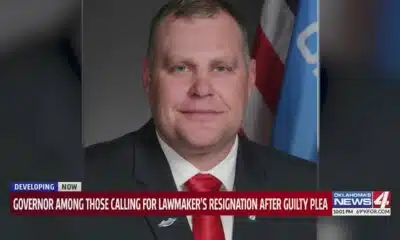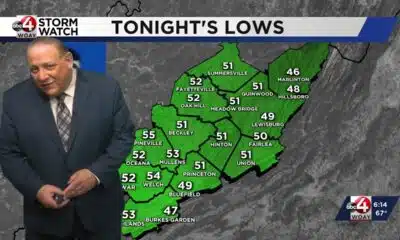News from the South - Texas News Feed
Why Kerr County balked on a new flood warning system
“Did fiscal conservatism block plans for a new flood warning system in Kerr County?” was first published by The Texas Tribune, a nonprofit, nonpartisan media organization that informs Texans — and engages with them — about public policy, politics, government and statewide issues.
Sign up for The Brief, The Texas Tribune’s daily newsletter that keeps readers up to speed on the most essential Texas news.
In the week after the tragic July 4 flooding in Kerr County, several officials have blamed taxpayer pressure as the reason flood warning sirens were never installed along the Guadalupe River.
“The public reeled at the cost,” Kerr County Judge Rob Kelly told reporters one day after the rain pushed Guadalupe River levels more than 32 feet, resulting in nearly 100 deaths in the county, as of Thursday.
/https://static.texastribune.org/media/files/024d0859980ef8978d239b5ed04ac727/0705%20Hill%20Country%20Flood%20RB%20TT%2094.jpg)
A community that overwhelmingly voted for President Donald Trump in 2016, 2020 and 2024, Kerr County constructed an economic engine on the allure of the Guadalupe River. Government leaders acknowledged the need for more disaster mitigation, including a $1 million flood warning system that would better alert the public to emergencies, to sustain that growth, but they were hamstrung by a small and tightfisted tax base.
An examination of transcripts since 2016 from Kerr County’s governing body, the commissioners court, offers a peek into a small Texas county paralyzed by two competing interests: to make one of the country’s most dangerous region for flash flooding safer and to heed to near constant calls from constituents to reduce property taxes and government waste.
“This is a pretty conservative county,” said former Kerr County Judge Tom Pollard, 86. “Politically, of course, and financially as well.”
County zeroes in on river safety in 2016
Cary Burgess, a local meteorologist whose weather reports can be found in the Kerrville Daily Times or heard on Hill Country radio stations, has noticed the construction all along the Guadalupe for the better part of the last decade.
More Texans and out-of-state residents have been discovering the river’s pristine waters lined with bald cypress trees, a long-time draw for camping, hiking and kayaking, and they have been coming in droves to build more homes and businesses along the water’s edge. If any of the newcomers were familiar with the last deadly flood in 1987 that killed 10 evacuating teenagers, they found the river’s threat easy to dismiss.
“They’ve been building up and building up and building up and doing more and more projects along the river that were getting dangerous,” Burgess recalls. “And people are building on this river, my gosh, they don’t even know what this river’s capable of.”
By the time the 1987 flood hit, the county had grown to about 35,000 people. Today, there are about 53,000 people living in Kerr County.
In 2016, Kerr County commissioners already knew they were getting outpaced by neighboring, rapidly growing counties on installing better flood warning systems and were looking for ways to pull ahead.
/https://static.texastribune.org/media/files/506c5dbfd4d30784a0102a07ac66c42c/07171987%20Seagoville%20Bus.png)
During a March 28 meeting that year, they said as much.
“Even though this is probably one of the highest flood-prone regions in the entire state where a lot of people are involved, their systems are state of the art,” Commissioner Tom Moser said then. He discussed how other counties like Comal had moved to sirens and more modern flood warning systems.
“And the current one that we have, it will give – all it does is flashing light,” explained W.B. “Dub” Thomas, the county’s emergency management coordinator. “I mean all – that’s all you get at river crossings or wherever they’re located at.”
Kerr County already had signed on with a company that allowed its residents to opt in and get a CodeRED alert about dangerous weather conditions. But Thomas urged the commissioners court to strive for something more. Cell service along the headwaters of the Guadalupe near Hunt was spotty in the western half of Kerr County, making a redundant system of alerts even more necessary.
“I think we need a system that can be operated or controlled by a centralized location where – whether it’s the Sheriff’s communication personnel, myself or whatever, and it’s just a redundant system that will complement what we currently have,” Thomas said that year.
By the next year, officials had sent off its application for a $731,413 grant to FEMA to help bring $976,000 worth of flood warning upgrades, including 10 high water detection systems without flashers, 20 gauges, possible outdoor sirens, and more.
“The purpose of this project is to provide Kerr County with a flood warning system,” the county wrote in its application. “The System will be utilized for mass notification to citizens about high water levels and flooding conditions throughout Kerr County.”
But the Texas Division of Emergency Management, which oversees billions of FEMA dollars designed to prevent disasters, denied the application because they didn’t have a current hazard mitigation plan. They resubmitted it, news outlets reported, but by then, priority was given to counties that had suffered damage from Hurricane Harvey.
Political skepticism about a windfall
All that concern about warning systems seemed to fade over the next five years, as the political atmosphere throughout the county became more polarized and COVID fatigue frayed local residents’ nerves.
In 2021, Kerr County was awarded a $10.2 million windfall from the American Rescue Plan Act, or ARPA, which Congress passed that same year to support local governments impacted by the pandemic. Cities and counties were given flexibility to use the money on a variety of expenses, including those related to storm-related infrastructure. Corpus Christi, for example, allocated $15 million of its ARPA funding to “rehabilitate and/or replace aging storm water infrastructure.” Waco’s McLennan County spent $868,000 on low water crossings.
Kerr County did not opt for ARPA to fund flood warning systems despite commissioners discussing such projects nearly two dozen times since 2016. In fact, a survey sent to residents about ARPA spending showed that 42% of the 180 responses wanted to reject the $10 million bonus altogether, largely on political grounds.
“I’m here to ask this court today to send this money back to the Biden administration, which I consider to be the most criminal treasonous communist government ever to hold the White House,” one resident told commissioners in April 2022, fearing strings were attached to the money.
“We don’t want to be bought by the federal government, thank you very much,” another resident told commissioners. “We’d like the federal government to stay out of Kerr County and their money.”
When it was all said and done, the county approved $7 million in ARPA dollars on a public safety radio communications system for the sheriff’s department and county fire services to meet the community’s needs for the next 10 years, although earlier estimates put that contract at $5 million. Another $1 million went to sheriff’s employees in the form of stipends and raises, and just over $600,000 went towards additional county positions. A new walking path was also created with the ARPA money.
While much has been made of the ARPA spending, it’s not clear if residents or the commissioners understood at the time they could have applied the funds to a warning system. Current Kerr County Judge Rob Kelly, and Thomas have declined repeated requests for interviews. Moser, who is no longer a commissioner, did not immediately respond to a Texas Tribune interview request.
Many Kerr County residents, including those who don’t normally follow every cog-turn of government proceedings, have now been poring over the county commissioners meetings this week including Ingram City Council member Raymond Howard. They’ve been digging into ARPA spending and other ways that the county missed opportunities to procure $1 million to implement the warning system commissioners wanted almost 10 years ago, and to prevent the devastating death toll from this week.
A week ago, Howard spent the early morning hours of July 4 knocking on neighbors’ doors to alert them to the flooding after he himself ignored the first two phone alerts on his phone in the middle of the night.
In the week since, the more he’s learned about Kerr County’s county inaction on a flood warning system, the angrier he has become.
“Well, they were obviously thinking about it because they brought it up 20 times since 2016 and never did anything on it,” Howard said, adding that he never thought to ask the city to install sirens previously because he didn’t realize the need for it. “I’m pretty pissed about that.”
Harvey Hilderbran, the former Texas House representative for Kerr County, said what he is watching play out in the community this week is what he’s seen for years in Texas: A disaster hits. There’s a rush to find out who’s accountable. Then outrage pushes officials to shore up deficiencies.
It’s not that Kerr County was dead set against making the area safer, Hilderbran said. Finding a way to pay for it is always where better ideas run aground, especially with a taxbase and leadership as fiscally conservative as Kerr’s.
“Generally everybody’s for doing something until it gets down to the details paying for it,” Hilderbran said. “It’s not like people don’t think about it … I know it’s an issue on their minds and something needs to be done.”
Howard, the 62-year-old Ingram city council member, came to Kerr County years ago to care for an ailing mother. Although he has now been diagnosed with stage four cancer, he said he intends to devote his life to make sure that his small two-mile town north of Kerrville has a warning system and he already knows where he’s going to put it.
“We’re going to get one, put it up on top of the tower behind the volunteer fire department,” he said. “It’s the thing I could do even if it’s the last thing I do …to help secure safety for the future.”
This article originally appeared in The Texas Tribune at https://www.texastribune.org/2025/07/10/texas-kerr-county-commissioners-flooding-warning/.
The Texas Tribune is a member-supported, nonpartisan newsroom informing and engaging Texans on state politics and policy. Learn more at texastribune.org.
The post Why Kerr County balked on a new flood warning system appeared first on feeds.texastribune.org
Note: The following A.I. based commentary is not part of the original article, reproduced above, but is offered in the hopes that it will promote greater media literacy and critical thinking, by making any potential bias more visible to the reader –Staff Editor.
Political Bias Rating: Center-Right
This article presents a mostly factual and balanced overview of Kerr County’s flood warning system challenges within a politically conservative community. It highlights the county’s strong conservative stance on limited government spending and skepticism toward federal aid, reflecting typical right-leaning priorities such as fiscal conservatism and wariness of federal involvement. The coverage is careful to present multiple perspectives, including official statements and local residents’ concerns, without overt editorializing or ideological framing. The tone and content suggest an objective report focused on local governance dynamics rather than promoting a partisan agenda, though the conservative context is clearly emphasized.
News from the South - Texas News Feed
Kerr youth camps seek Patrick’s help on proposed flood rules
“Kerr County youth camps appeal to Dan Patrick on proposed floodplain restrictions” was first published by The Texas Tribune, a nonprofit, nonpartisan media organization that informs Texans — and engages with them — about public policy, politics, government and statewide issues.
Sign up for The Brief, The Texas Tribune’s daily newsletter that keeps readers up to speed on the most essential Texas news.
The owners of three Kerr County youth camps have asked Lt. Gov. Dan Patrick to reconsider some of the stricter new flood safety requirements contained in two bills before the Texas Legislature that have been filed as a result of the tragic July 4 Guadalupe River flooding that killed 27 Camp Mystic campers.
Two camp safety bills, House Bill 1 and Senate Bill 1, would withhold state licensing if cabins are located in a floodplain. A week ago, both bills were passed by their respective home chambers.
Late Friday, The Texas Tribune obtained an Aug. 28 letter sent to Patrick by the owners of Camp Waldemar, Vista Camps and Camp Stewart. In it, the camp owners cite the cost of rebuilding cabins and ask Patrick to “work with us” by having an expert to propose “a safe and professionally analyzed solution through the Texas Water Development Board for the 100-year floodplain prohibition.”
The camp owners also insisted that there “must be meaningful financial support, whether through insurance, state grants, or other funding mechanisms, so that the burden does not fall solely on families, camps, and communities.”
State Sen. Charles Perry, R-Lubbock, who chairs the Senate Select Committee on Disaster Preparedness and Flood and the primary author of one of the bills, told the Tribune last week there would be no state assistance for camps to comply with pending legislation if it passes.
“No, camps are private enterprises,” Perry told The Texas Tribune after family members of the 27 Camp Mystic flood victims testified before his committee on Aug. 20. “The state’s not rebuilding private sector camps.”
The Texas Tribune reached out to Patrick’s office for comment on the letter, which was also forwarded to members of the Texas Senate and Gov. Greg. Abbott, and did not get an immediate response. The Tribune left phone messages at all three camps, asking for more detail and comment on the letter, but none were returned. The Tribune reached Meg Clark, executive director of Camp Waldemar late Friday. She confirmed the contents of the letter but declined to offer additional comment.
The two special legislative committees appointed after the July 4 disaster so far in public hearings have resisted discussing restricting development in floodplains statewide. Requiring camps to move cabins out of the floodplain was the biggest step they had taken in that direction — and is a major piece of the legislation. Flooding experts say getting kids out of risky areas as they sleep is a clear way to help protect them.
Originally, legislators had planned just to require that camps evacuate kids from campgrounds in the floodplain if the weather service issued a flash flood warning and to install ladders on cabins so campers could climb onto rooftops if the situation grew dire and for some reason they hadn’t evacuated. But parents of the kids who died at Camp Mystic pushed to get more restrictive, camp-focused legislation on the table.
“The combination of devastating floods and the heavy financial burden proposed under new state regulations presents an impossible challenge,” the camps’ letter stated. “Collectively, our camps would face millions of dollars in mandated rebuilding costs for cabins subjected to the prohibition that did not sustain damage by recent flooding. These additional burdens would come on top of already significant flood repairs, operational expenses, and existing loans.”
A representative for the Camp Mystic families’ campaign for camp safety said, “We believe the parents’ testimonies and recent media interviews speak for themselves. We have no comment about this letter, but we support lawmakers’ efforts to pass SB1 and HB1 to ensure common sense safety reforms are in place for the 2026 summer camp season.”
More all-star speakers confirmed for The Texas Tribune Festival, Nov. 13–15! This year’s lineup just got even more exciting with the addition of State Rep. Caroline Fairly, R-Amarillo; former United States Attorney General Eric Holder; Abby Phillip, anchor of “CNN NewsNight”; Aaron Reitz, 2026 Republican candidate for Texas Attorney General; and State Rep. James Talarico, D-Austin. Get your tickets today!
TribFest 2025 is presented by JPMorganChase.
This article originally appeared in The Texas Tribune at https://www.texastribune.org/2025/08/29/texas-legislature-flooding-youth-camps/.
The Texas Tribune is a member-supported, nonpartisan newsroom informing and engaging Texans on state politics and policy. Learn more at texastribune.org.
The post Kerr youth camps seek Patrick’s help on proposed flood rules appeared first on feeds.texastribune.org
Note: The following A.I. based commentary is not part of the original article, reproduced above, but is offered in the hopes that it will promote greater media literacy and critical thinking, by making any potential bias more visible to the reader –Staff Editor.
Political Bias Rating: Centrist
The content presents a balanced report on legislative efforts related to flood safety regulations for youth camps in Texas. It includes perspectives from camp owners concerned about financial burdens and state legislators emphasizing private enterprise responsibility, without overtly favoring either side. The article maintains a neutral tone and focuses on factual reporting, reflecting a centrist viewpoint.
News from the South - Texas News Feed
New cockpit technology could reduce close calls
SUMMARY: Honeywell Aerospace has developed a prototype Surface Alert System (SURF A) designed to prevent runway incursions, which occur when planes enter runways without authorization. Using GPS technology, SURF A provides pilots with two warnings—30 seconds and 15 seconds before a potential collision—helping them avoid close calls during takeoffs and landings. Since 2020, engineers have worked on this system amid rising concerns: the FAA reported over 1,500 runway incursions last year, seven nearly causing collisions. While infrastructure improvements remain crucial, pilots are the final defense. Honeywell aims for certification next month and hopes airlines will adopt the technology early next year.
There’s a new alert system being tested that is designed to reduce close calls on airport runways. FOX’s Asher Reed is in Kansas City with a look at the technology.
Subscribe to FOX 4: https://www.youtube.com/fox4news?sub_confirmation=1
Dallas news, weather, sports and traffic from KDFW FOX 4, serving Dallas-Fort Worth, North Texas and the state of Texas.
Watch FOX 4 Live: https://www.fox4news.com/live
Download the FOX 4 News App: https://www.fox4news.com/apps
Download the FOX 4 WAPP: https://www.fox4news.com/apps
Follow FOX 4 on Facebook: https://www.facebook.com/Fox4DFW/
Follow FOX 4 on Twitter: https://twitter.com/FOX4
Follow FOX 4 on Instagram: https://www.instagram.com/fox4news/
Subscribe to the FOX 4 newsletter: https://www.fox4news.com/newsletters
News from the South - Texas News Feed
Rizzbot secrets revealed: Who is the mechanical man stalking Austin?
SUMMARY: Rizzbot is a three-foot-tall humanoid robot, wearing a cowboy hat, gaining popularity in Austin with nearly 500K TikTok followers and over 20 million likes. Built on a Unitree G1 platform costing about $15K-$50K with upgrades, Rizzbot weighs 77 lbs and performs dances taught at the University of Texas through motion capture technology. Operated remotely by an anonymous former YouTuber and biochemist, Rizzbot entertains crowds with preprogrammed moves, embodying charisma (“rizz”). UT Austin researchers developed its fluid motions and safety features. Seen around Austin and other cities, Rizzbot challenges stereotypes, making robots approachable and fun.
The post Rizzbot secrets revealed: Who is the mechanical man stalking Austin? appeared first on www.kxan.com
-
News from the South - Texas News Feed4 days ago
Racism Wrapped in Rural Warmth
-
News from the South - Texas News Feed7 days ago
DEA agents uncover 'torture chamber,' buried drugs and bones at Kentucky home
-
News from the South - Missouri News Feed6 days ago
Donors to private school voucher program removed from Missouri transparency site
-
News from the South - Florida News Feed7 days ago
Ukraine’s independence-era voices say Russia’s effort to keep control has lasted decades
-
News from the South - Texas News Feed5 days ago
Texas Democrats’ walkout prompts GOP retribution
-
News from the South - Alabama News Feed5 days ago
Child in north Alabama has measles, says Alabama Department of Public Health
-
News from the South - Tennessee News Feed2 days ago
New developments in Pauline Pusser case
-
News from the South - Georgia News Feed5 days ago
Voters head to the polls to pick new metro Atlanta state senator in low-turnout special election








































